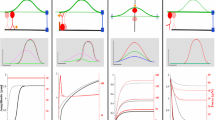Summary
The lipotubuloids ofOrnithogalum umbellatum consisting of osmiophilic granules surrounded by a system of microtubules move from one place to another within a cell by means of a progressive rotary motion.
It was proved that the rotary motion of the lipotubuloids is autonomous, while their progressive motion depends on cyclosis. DNP causes cyclosis to stop earlier than does the rotary motion of the lipotubuloid. The peripheral speed of the rotating lipotubuloid reaches 31.4Μ/sec and is 6.2 times faster than the maximum speed of the cytoplasmic motion.
The diameter of microtubules in the lipotubuloids changes, and these changes are connected with the lipotubuloid motion. Those rotating at a speed of 60‡ to 360‡/sec consist of two equally numerous populations of microtubules:A) from 14 to 20 nm, andB) from 22 to 28 nm. In the lipotubuloids whose rotation is considerably slower, the great majority of microtubules are 14 to 20 nm in diameter, and the B population constitutes only 10%. The immobilization of the quickly rotating lipotubuloids through the action of DNP results in destruction of the two microtubule populations, so that only one population is present. This has intermediate diameters ranging from 16 to 24 nm. The removal of DNP restores the intense rotary motion of the lipotubuloids and brings about the reappearance of the population of microtubules ranging from 22 to 28 nm in diameter.
The increase in microtubule diameters results most probably from shortening of the microtubules. It can be supposed that the contraction of microtubules is the source of the motive force responsible for the rotary motion of the lipotubuloids.
Similar content being viewed by others
References
Burgess, J., 1970: The occurrence of crosslinked microtubules in a higher plant cell. Planta92, 25–28.
DuPraw, J. E., 1968: Cell and molecular biology. New York & London: Academic Press.
Gibbons, I., andA. J. Rowe, 1965: Dynein: a protein with adenosine triphosphatase activity from cilia. Science149, 424.
Hepler, P. K., J. R. McIntosh, andS. Cleland, 1970: Intermicrotubule bridges in mitotic spindle apparatus. J. Cell Biol.45, 438–444.
Kamiya, N., 1959: Protoplasmic streaming, ProtoplasmatologiaVIII 3a, 1–199. Wien: Springer-Verlag.
Kwiatkowska, M., 1970: Ultrastrukturalne, cytochemiczne i przyzyciowe badania elajoplastów roŚlin kwiatowych, łódź, Uniwersytet łódzki.
—, 1971 a: Fine structure of lipotubuloids (elaioplasts) inOrnithogalum umbellatum L. Acta Soc. Bot. Pol.40, 451–465.
—, 1971 b: Fine structure of lipotubuloids (elaioplasts) inOrnithogalum umbellatum in the course of their development. Acta Soc. Bot. Pol.40, 529–537.
McIntosh, J. R., P. K. Hepler, andD. G. Van Wie, 1969: Model for mitosis. Nature224, 659–663.
Wilson, H. J., 1969: Arms and bridges on microtubules in the mitotic apparatus. J. Cell Biol.40, 854–859.
Author information
Authors and Affiliations
Rights and permissions
About this article
Cite this article
Kwiatkowska, M. Changes in the diameter of microtubules connected with the autonomous rotary motion of the lipotubuloids (elaioplasts). Protoplasma 75, 345–357 (1972). https://doi.org/10.1007/BF01282114
Received:
Issue Date:
DOI: https://doi.org/10.1007/BF01282114




